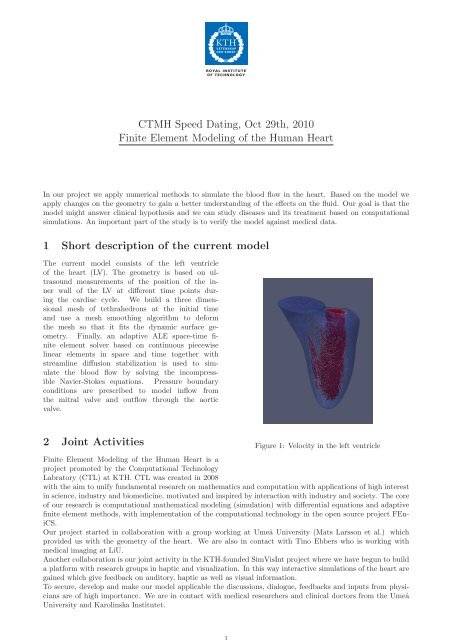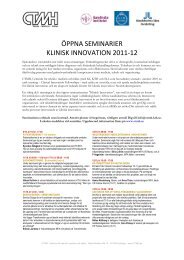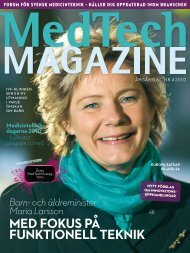Visualisering av funktionell och morfologisk hjärt-kärl-diagnostik
Visualisering av funktionell och morfologisk hjärt-kärl-diagnostik
Visualisering av funktionell och morfologisk hjärt-kärl-diagnostik
You also want an ePaper? Increase the reach of your titles
YUMPU automatically turns print PDFs into web optimized ePapers that Google loves.
CTMH Speed Dating, Oct 29th, 2010<br />
Finite Element Modeling of the Human Heart<br />
In our project we apply numerical methods to simulate the blood flow in the heart. Based on the model we<br />
apply changes on the geometry to gain a better understanding of the effects on the fluid. Our goal is that the<br />
model might answer clinical hypothesis and we can study diseases and its treatment based on computational<br />
simulations. An important part of the study is to verify the model against medical data.<br />
1 Short description of the current model<br />
The current model consists of the left ventricle<br />
of the heart (LV). The geometry is based on ultrasound<br />
measurements of the position of the inner<br />
wall of the LV at different time points during<br />
the cardiac cycle. We build a three dimensional<br />
mesh of tethrahedrons at the initial time<br />
and use a mesh smoothing algorithm to deform<br />
the mesh so that it fits the dynamic surface geometry.<br />
Finally, an adaptive ALE space-time finite<br />
element solver based on continuous piecewise<br />
linear elements in space and time together with<br />
streamline diffusion stabilization is used to simulate<br />
the blood flow by solving the incompressible<br />
N<strong>av</strong>ier-Stokes equations. Pressure boundary<br />
conditions are prescribed to model inflow from<br />
the mitral valve and outflow through the aortic<br />
valve.<br />
2 Joint Activities<br />
Figure 1: Velocity in the left ventricle<br />
Finite Element Modeling of the Human Heart is a<br />
project promoted by the Computational Technology<br />
Labratory (CTL) at KTH. CTL was created in 2008<br />
with the aim to unify fundamental research on mathematics and computation with applications of high interest<br />
in science, industry and biomedicine, motivated and inspired by interaction with industry and society. The core<br />
of our research is computational mathematical modeling (simulation) with differential equations and adaptive<br />
finite element methods, with implementation of the computational technology in the open source project FEniCS.<br />
Our project started in collaboration with a group working at Ume˚a University (Mats Larsson et al.) which<br />
provided us with the geometry of the heart. We are also in contact with Tino Ebbers who is working with<br />
medical imaging at LiU.<br />
Another collaboration is our joint activity in the KTH-founded SimVisInt project where we h<strong>av</strong>e begun to build<br />
a platform with research groups in haptic and visualization. In this way interactive simulations of the heart are<br />
gained which give feedback on auditory, haptic as well as visual information.<br />
To secure, develop and make our model applicable the discussions, dialogue, feedbacks and inputs from physicians<br />
are of high importance. We are in contact with medical researchers and clinical doctors from the Ume˚a<br />
University and Karolinska Institutet.




